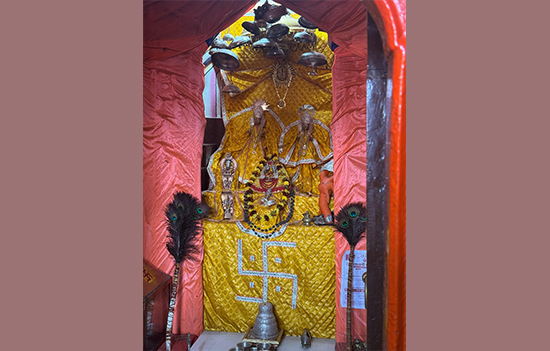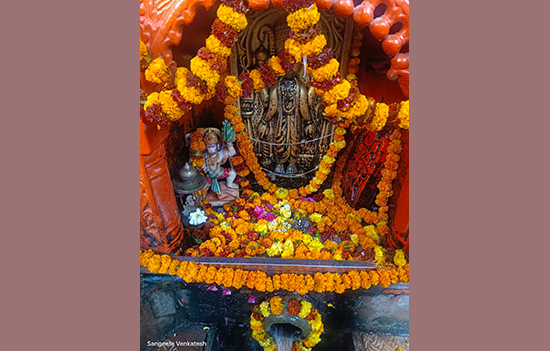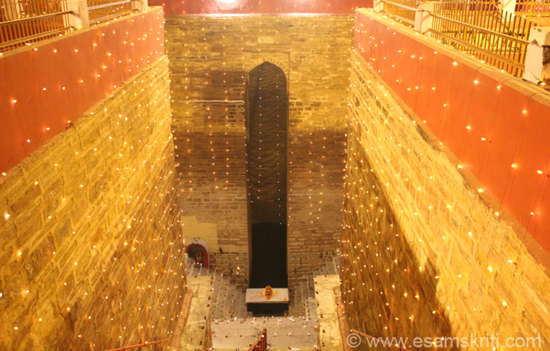- The origin of the Surya Mandir at
Lohargal lies in the Mahabharata, origin of Maheshwari community and penance by
Lord Parashurama.
According to tradition, after the great
war of the Mahabharata, the Pandavas sought to atone for the bloodshed and were
advised by Lord Krishna to undertake a pilgrimage. He told them that their sins
would be absolved only when their weapons dissolved in a water body during
their journey. Their pilgrimage led them to Lohargal, where they bathed in the
sacred waters of the Surya Kund.
It is believed that when they immersed
their blood-stained weapons in the kund, the iron melted away, symbolizing
their purification and redemption. This tradition gives Lohargal its name,
derived from Loha (iron) and Gal (dissolve).
Nestled in a valley amid the Aravalli hills, the Lohargal Surya Temple, located near Udaipurwati in Rajasthan’s Shekhawati region, is a revered pilgrimage site. Dedicated to Surya, the Sun God, the temple is best known for its sacred water tank, the Surya Kund.
Another prominent tradition associated
with Lohargal narrates the origins of the Maheshwari community.
It tells the story of Sujansen, the prince of Khandela, who once visited Lohargal. Disrespecting the sages and yogis engaged in sacred rituals, he incurred their wrath, and they transformed him and his soldiers into stone idols. Moved by the heartfelt pleas of the soldiers’ wives, Lord Maheshwar (Shiva) restored them to human form. He instructed them to bathe in the Surya Kund, where their weapons dissolved in the waters. Lord Maheshwar then advised them to renounce their warrior lifestyle.
Following his divine command, they devoted themselves to trade and worship, forming the Maheshwari community. Over time, the Maheshwaris became known for their business acumen and are now among India’s leading business groups, with notable families such as the Birlas and Lohias emerging from this lineage.
Yet another tale recounts that Lord
Parashurama performed penance here to atone for slaying the corrupt Kshatriya
rulers.
 The main Surya and Chaya shrine.
The main Surya and Chaya shrine.
Historically, local lore attributes the
construction of the Lohargal Sun Temple to King Suryabhan. The king had a
differently-abled daughter, and his advisors suggested that she bathe in the
Surya Kund. Miraculously, her limbs became normal after taking a dip in the
holy waters.
This temple is unique as it is one of
the few in India where Surya is depicted alongside
his consort, Chhaya. The temple follows the Ramanuja Sampradaya. The
Ramanuja Sampradaya, also known as the Sri Vaishnava Sampradaya, is one of the
main traditions within Hinduism, specifically within the Vaishnavism branch. It
is named after its founder, Ramanuja, who lived in the 11th and 12th centuries.
 Lord Vishnu in the form of Surya.
Lord Vishnu in the form of Surya.
During my visit, I also came across
temples dedicated to Sri Suka, the son of Sage Vyasa and the narrator of the Bhagavata
Purana to King Parikshit.
Lohargal holds a special place in Hindu
tradition and devotees believe that bathing in the Surya Kund washes away sins
and leads to spiritual purification. The temple draws pilgrims during
auspicious occasions. I was there on Makara Sankranti which was a significant
day of worship.
Lohargal is also well known for its
delicious pickles, with rows of shops selling a variety of flavors.
 Lolarak Kund in Kashi is dedicated t Surya. It is about 10 minutes from Dasashvamedha Ghat.
Lolarak Kund in Kashi is dedicated t Surya. It is about 10 minutes from Dasashvamedha Ghat.
How to reach and Stay
Lohargal is accessible by road from
Jaipur, located midway between Udaipurwati and Sikar. However, finding good
restrooms here can be challenging, and parking is difficult unless you travel
with a chauffeur. Fortunately, there are some good resorts and we had our lunch
break at the Hukumgarh Resort.
To read all
articles by author All Lohargal Temple pictures by author.
Also
see albums
1. Sun Temple
Konarak Odisha
2. Surya
Temple Modhera Gujarat
3. Martand
Surya Temple Kashmir
4. Sun Temple Almora Uttarakhand
5. Why
Marwaris take to Business
6. Life
and thoughts of Ramanuja Andhra
Pradesh